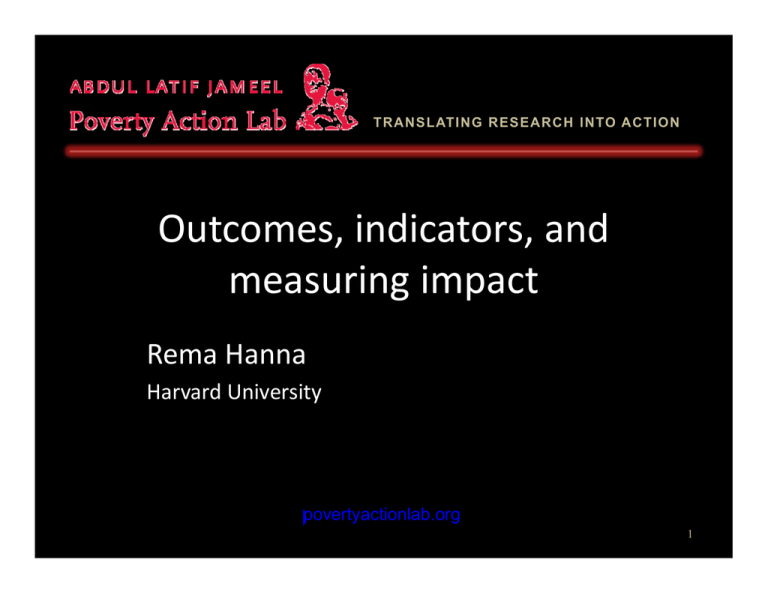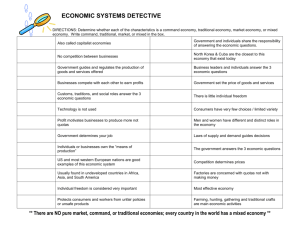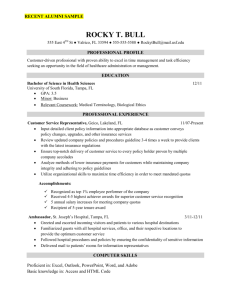Outcomes, indicators, and measuring impact Rema Hanna Harvard University
advertisement

TRANSLATING RESEARCH INTO ACTION Outcomes, indicators, and measuring impact Rema Hanna Harvard University povertyactionlab.org 1 Course Overview 1. 1 2. 3 3. 4. 5. 6 6. 7. Why evaluate? What is evaluation? Outcomes, indicators and measuring impact Impact evaluation l i – why h randomize d i How to randomize Sampling and Sample Size Analysis and inference RCTs: Start to Finish 2 Goals of measurement • Needs Assessment: – Identifying problems/constraints that might help us choose among possible interventions/experiment • Background Information: – Describing the environment within which the i intervention/experiment i / i takes k place l • Process Evaluation: – Measuring M i the th inputs i t into i t the th intervention i t ti – Assessing the implementation of the intervention • Impact Evaluation: – Measuring the outcomes/impact of the intervention 3 Lecture Overview • Outcomes and indicators • Logical Model • Data Collection C ll i 4 Lecture Overview • Outcomes and indicators – Intended goals – Unintended consequences – Possible outcomes and indicators • Logical L i l Model M d l • Data Collection 5 The setting: Quotas in the Village Councils 6 The setting: Quotas in the Village Councils • What are the main goals of the Village Council? • What are the main characteristics of the quota policy? li ? 7 The controversy about quotas • Why were quotas deemed to be desirable in this context? • Why did some people doubt that quotas would ld be b effective? ff i ? 8 The possible effects • Let Let’ss start by drawing a list of everything we think quotas for women may affect. 9 Multiple (primary/final) outcomes • Suppose that you collect data on 20 different outcomes – You find one is significantly positive – You find one is significantly negative – You find that for 18, the outcomes are very similar, and not significantly i ifi l different diff • What can you conclude? Define key hypotheses before the beginning of the experiment 10 Defining key hypotheses • What might be examples of a few key hypotheses to test? • Which variables,, or combinations of variables,, might you use to test these key hypotheses? 11 Lecture Overview • Outcomes and indicators • Logical Model – Key K h hypotheses th and d chain h i off causality lit – Hints on data collection • Data Collection 12 Drawing the chain of causality Drawing the chain of causality • We want to answer more than: – how effective is the intervention? • We also want to answer: – why it is effective? • We want to draw the link inputs intermediary outcomes primary outcome Defining and measuring intermediate outcomes will enrich our understanding of the program, reinforce our conclusions, and make it easier to draw general lessons 14 13 Modeling the effe effects of quotas • What are the possible chains of outcomes in the case of the quotas? • What are the critical steps steps needed to obtain a the final results? • What Wh variables i bl should h ld we try to obtain b i at every step of the way to discriminate between various i models d l ?? 14 A theory of change… A theory of change… Quotas Imperfect Democracy Some democracy Pradhan’s preferences matter Women are empowered Different Public goods More women Pradhans Women have different preferences Public goods reflect women’s preference Different health, education Outcomes? 15 Model with indicators: f l l l d quotas for local women leaders Needs Women have poor health and low levels of education. Their needs are not represented in local government Input Reserved seats for women leaders Output More local women leaders Outcome Women more engaged and more directly involved in political decision making Impact (primary outcome) Different public bli goods. Better education and health outcomes Long Long-term term Goal Gender lit iin equality health, education. Quotas no g longer necessary? INDICATORS: Gender of leader Budget allocations change. Female attendance in council meetings. Literacy level. BMI for girls girls, boys. 16 Lecture Overview • Outcomes and indicators • Logical Model • Data Collection C ll i – In practice – Data Entry – Ethics 17 Data collected in panchayat study Tool GP Interview Target Target Outcomes Respondent Village Leader Transcript of Gram Sabha GP o Pradhan’s background (socioeconomic status, education) o Political ambitions o Political experience o Investments undertaken o Public records. such as GP balance sheets o Who speaks and when (gender) o For how long do they speak? o What issues do they raise? 18 Data collected in panchayat study Tool Target Target Outcomes Respondent Village Participatory 10 to 20 Resource Appraisal villagers per (village mapping exercise village and focus groups) Household interviews o Village infrastructure (schools, roads, wells, SC and ST areas, cultivated land, irrigation, energy projects) Perception of quality of different public goods Participation of men and women in activities What issues villagers have raised with GP o HH demographic and socioeconomic Head of data household (the male in HH outcomes (child heath, measurement of some HH; the heightt and weight, heigh weight, etc.) etc.) HH perceptions of quality of public goods female in and services other HH) Declared HH preferences 19 Data collected in panchayat study Target Target Outcomes Respondent Existing administrative Public data o A snapshot of village characteristics—population, public archives data goods, demographics, etc.—at the (national, time of the 1991 and 2001 census GP, and o Expenditures di on public bli goods d and d Village) ll ) services in GP (from GP balance sheets) o Issues addressed at GP public assemblies (from Gram Sabha minutes) Tool 20 Why collect llect your own data data? • To get the da data ta on the variables that you are interested in • To get adequate adequate coverage coverage of the treated ea e (and control) population • To T get coverage off the h treated d population l i at the appropriate time 21 Why not collect field data? A surveyor in Udaipur, India, searches for a respondent 22 Why not collect field data? • Time Time‐consuming consuming, risky, risky drawn drawn‐out out process • High turnover of civil servants Æmay lose your advocate in an office/ministry Æmay lose permission to do research • Survey company fails to honor contract • Poor P d quality data li and d need d to return to field fi ld • Natural/human disasters • Lots of management 23 Should you do a baseline? • Technically ec ca u dodoonoteed o to: you need – Treatment vs comparison endline is unbiased, so consider putting budget into larger sample • However, baseline allow us to: – Check that randomization worked – Control for baseline characteristics, especially lagged value of outcome of interest (Other covariates could potentially soak up variation, but usually not much) – Baseline allow allowss interactions 24 When to do the endline • Outcomes for educational interventions seem to change over time • Multiple p waves of measurement – Results at one stage can help in securing funding for later stages g – Increased precisions – Collect data at each stage g to help p find respondents p later 25 Consider constraints when surveying • Financial resources – tradeoff between sample size and amount of information obtained from each household • Human resource capacity of organization implementing the surveyr survey – research – searc h coordinators, interviewers, data entry staff • Willingness Willi and d ability bili off respondents d to provide desired information – For example, some people may not know how old they are. 26 Respondent willingness and ability • Willingness to provide desired information: • Use objective j measures if treatment or act of measurement may influence measurement • Ability b l to provide d information: • Pp Perceptions ti vs. reality lit 27 Data collection, I • If sampling a larger target population, you will want a household‐level census • Data entry format must be clear and should not leave leave room for interpretation by the enumerator. 28 Data collection, II • Contracting out vs. employing enumerators directly? • Training enumerators in these procedures is essential Cr essential. Create eate manuals for all survey instruments. New surveyors learning to use health equipment in Udaipur, India. Training off 45 surveyors llasted t d tttt wo weeks. k 29 Data collection, III • Need daily or weekly check of all the forms by a supervisor, and a re‐check on a random d b i b basis by the th research h manager • Re‐survey sample of respondents on a random basis 30 Data ta collection, IV • Data collected in multiple rounds • Names and dates of enumerators f on forms and dates of survey • Forms whose p pages g can be separated 31 llection, V Data collection, • Can do some interesting randomizations during data collection (especially the pilot) – – – – – – Order of questions Nature of question Framing of question Characteristics e of enumerator enumera ors Frequency of data collection Form and value of compensation for respondents (if applicable) • Check if these systematically affect responses – If they do, potential problems with measurement – Might not be measuring parameters you’re intending to measure 32 Data collection, llection, VI • Field team includes interviewers and supervisors • A superv e supervisor ro role • Ideal team size under one supervisor depends on area off survey, length l h off questionnaire(8 i i (8 to 10 typical) • Payment structure for team and ensuring high data quality Grosh and Glewwe, 2005 33 Piloting the survey • Pilots vary in size & rigor • Pilots & qualitative steps are important • Something always goes wrong – Respondents might not understand a question • Better to find this out before study begins • Often discover other interesting questions in process 34 Data entry Enter data quickly to catch problems When entering data assign a Survey Number to each questionnaire Scan documents I Invest in a good data entry data base (can use a software firm). i dd d b ( f fi ) Do double entry of all data and reconcile with the hard copies to detect mistakes. • Re‐enter some entries a third time (supervisor) and seek to achieve less than 0.5% error rate. • After After re‐entry, clean data. re entry clean data • • • • • 35 Data en try Increasingly possible to do things on laptops, PDAs, and cell phones in the field. Goes directly to a data base (e.g. Datadine and Google’s Android platforms) Courtesy of Chris Blattman. Used with permission. 36 Budgeting • Budget adequately • Things go wrong – Exchange h rate t movements t – Enumerator downtime – Resurveys needed • New opportunities 37 Human subjects • Check what approvals needed – Country IRBs – University IRBs • Allow adequate time • Oral vs. written consent • Permissions wha – National government g – Local authorities – Relevant ministry 38 Hints on outcomes and indicators 39 Hints on outcomes and indicators • Choose those with a reasonable chance of being “moved” within the evaluation timeline • Chose those that are not too difficult to collect and measure • Chose those that occur with enough frequency to detect an impact given your sample size 40 Comparing outcomes across studies • What do we do if some tests are easier than others? • We “standardize” or “normalize” – testscorenormalized = (testscore‐average testscore)/ standard deviation of testscore ) 41 MIT OpenCourseWare http://ocw.mit.edu Resource: Abdul Latif Jameel Poverty Action Lab Executive Training: Evaluating Social Programs Dr. Rachel Glennerster, Prof. Abhijit Banerjee, Prof. Esther Duflo The following may not correspond to a particular course on MIT OpenCourseWare, but has been provided by the author as an individual learning resource. For information about citing these materials or our Terms of Use, visit: http://ocw.mit.edu/terms.






